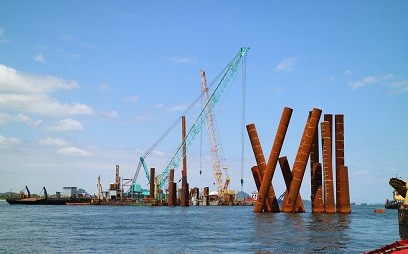From September 15 to 19, the Northern Beltway — a project carried out by Odebrecht Engenharia e Construção and...
Tenenge concludes the driving of piles in Terminal GásSul
DATE: 03/24/2022

Started in October 2021, the pile driving work for the FSRU (Floating Storage Regasification Unit) anchoring terminal of Terminal GásSul (TGS), under construction in Babitonga Bay (SC), was concluded last March 12, ahead of the deadline established in the construction schedule. In this period, 85 piles ranging from 48 to 57 meters in length each were driven, totaling 4.68 kilometers of pipes and a total load of 1,470 tons. The services were completed within international quality specifications, with no lost time accidents.
“We had to overcome numerous challenges, such as the weather conditions, in a project where logistics is essential for success. We were fully successful thanks to the dedication and commitment of each member involved in the activities, both at sea and on land, without ever renouncing safety, quality, and respect for the environment,” says Ricardo Corregio, the manager responsible for the offshore works.
With the conclusion of this stage, the TGS project has reached 60.3% physical progress, and is expected to be delivered in August of this year. The construction work currently generates 935 jobs in the region.
When it is ready, the Terminal will have the capacity to regasify 15 million cubic meters of LNG per day. The undertaking is the result of an investment of more than BRL380 million and should increase by more than 3 times the availability of Liquefied Natural Gas for the state of Santa Catarina. It will be more than 32 kilometers of pipeline, on and offshore, until it is definitively connected to the Brazil-Bolivia gas pipeline (Gasbol), operated by TBG.
The TGS will be located 300 meters offshore. It includes infrastructure to receive, store, regasify, and distribute the natural gas, which will arrive by sea through methane carriers and will be transferred by the ship to ship system to a FSRU (floating storage and regasification unit), which has the capacity to store 160,000 cubic meters of LNG. After regasification, the natural gas continues for about 2 kilometers in a pipeline under the bed of the bay, until it flows into the same entry point of the OSPAR pipeline, in Itapoá, ensuring minimal occupation of the aquatic space and little interference in the water mirror. On land, the natural gas will be transported by a 31-kilometer pipeline to the connection point with Gasbol, in the city of Garuva.
“This new gas pipeline will guarantee local supply and will propitiate the development of the region, supporting the advance of industry in the state and expanding the supply of gas in the South, Southeast and Center-West of the country. Carrying out a venture of this importance encourages us to continue serving our customers with excellence in service provision, a hallmark of Tenenge throughout its history”, says Marcelo Hofke, general director of the company.



No comments